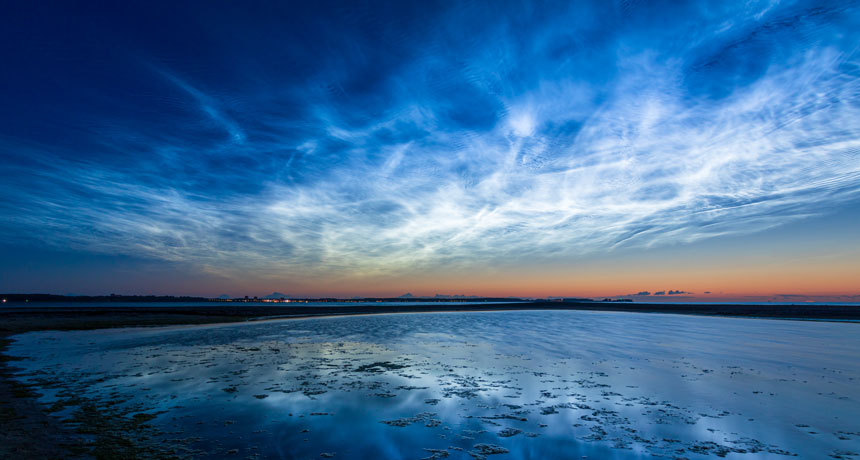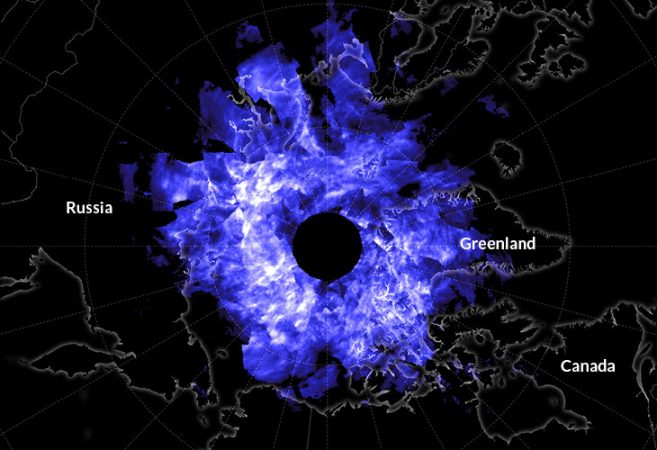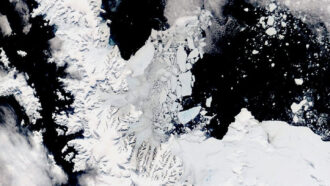Arctic A region that falls within the Arctic Circle. The edge of that circle is defined as the northernmost point at which the sun is visible on the northern winter solstice and the southernmost point at which the midnight sun can be seen on the northern summer solstice. The high Arctic is that most northerly third of this region. It’s a region dominated by snow cover much of the year.
atmosphere The envelope of gases surrounding Earth or another planet.
chemical reaction A process that involves the rearrangement of the molecules or structure of a substance, as opposed to a change in physical form (as from a solid to a gas).
cloud A plume of molecules or particles, such as water droplets, that move under the action of an outside force, such as wind, radiation or water currents. (in atmospheric science) A mass of airborne water droplets and ice crystals that travel as a plume, usually high in Earth’s atmosphere. Its movement is driven by winds.
condense To become thicker and more dense. This could occur, for instance, when moisture evaporates out of a liquid. Condense can also mean to change from a gas or a vapor into a liquid. This could occur, for instance, when water molecules in the air join together to become droplets of water.
crystal (adj. crystalline) A solid consisting of a symmetrical, ordered, three-dimensional arrangement of atoms or molecules. It’s the organized structure taken by most minerals. Apatite, for example, forms six-sided crystals. The mineral crystals that make up rock are usually too small to be seen with the unaided eye.
develop To emerge or come into being, either naturally or through human intervention, such as by manufacturing.
global warming The gradual increase in the overall temperature of Earth’s atmosphere due to the greenhouse effect. This effect is caused by increased levels of carbon dioxide, chlorofluorocarbons and other gases in the air, many of them released by human activity.
iridescent Adjective that describes something that seems to change color with a shift in the angle at which it is viewed or at which lighting is applied.
latitude The distance from the equator measured in degrees (up to 90). Low latitudes are closer to the equator; high latitudes are closer to the poles.
mesosphere The highest part of Earth’s atmosphere where all of the gases are all still well-mixed, not merely layered on the basis of each gas’s mass. This layer, found immediately above the stratosphere, is 35 kilometers (22 miles) thick. It’s the uppermost layer of the atmosphere with enough gas to cause friction for incoming space rocks. That’s why this region is where most meteor’s burn up. It varies somewhat in height, but tends to span about 50 to 80 kilometers (30 to 50 miles) above Earth’s surface.
methane A hydrocarbon with the chemical formula CH4 (meaning there are four hydrogen atoms bound to one carbon atom). It’s a natural constituent of what’s known as natural gas. It’s also emitted by decomposing plant material in wetlands and is belched out by cows and other ruminant livestock. From a climate perspective, methane is 20 times more potent than carbon dioxide is in trapping heat in Earth’s atmosphere, making it a very important greenhouse gas.
model A simulation of a real-world event (usually using a computer) that has been developed to predict one or more likely outcomes. Or an individual that is meant to display how something would work in or look on others.
NASA Short for the National Aeronautics and Space Administration. Created in 1958, this U.S. agency has become a leader in space research and in stimulating public interest in space exploration. It was through NASA that the United States sent people into orbit and ultimately to the moon. It also has sent research craft to study planets and other celestial objects in our solar system.
particle A minute amount of something.
reflective Adjective that refers to the ability of something to reflect light strongly. Such objects can produce a strong bright glare when sunlight bounces off of them. Examples of reflective objects include a mirror, a smooth metal can, a car window, a glass bottle, ice, snow or the watery surface of a lake.
satellite A moon orbiting a planet or a vehicle or other manufactured object that orbits some celestial body in space.
water vapor Water in its gaseous state, capable of being suspended in the air.









